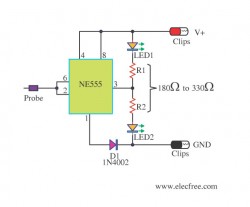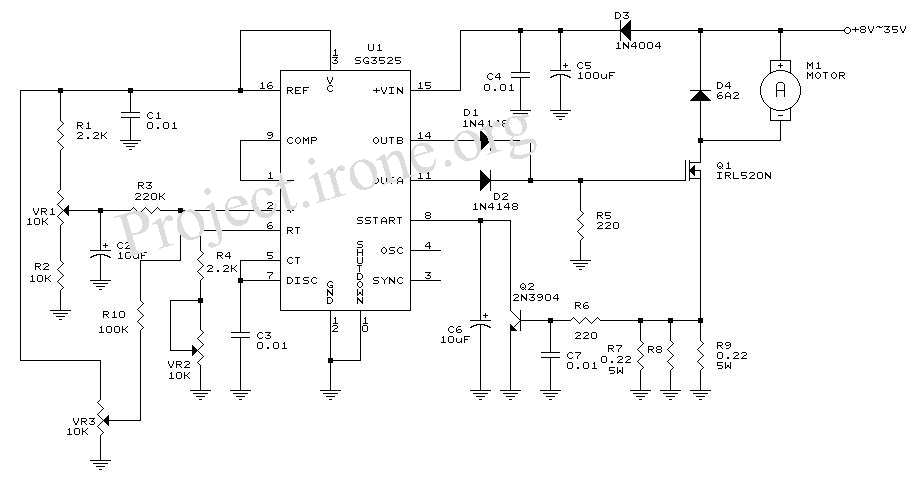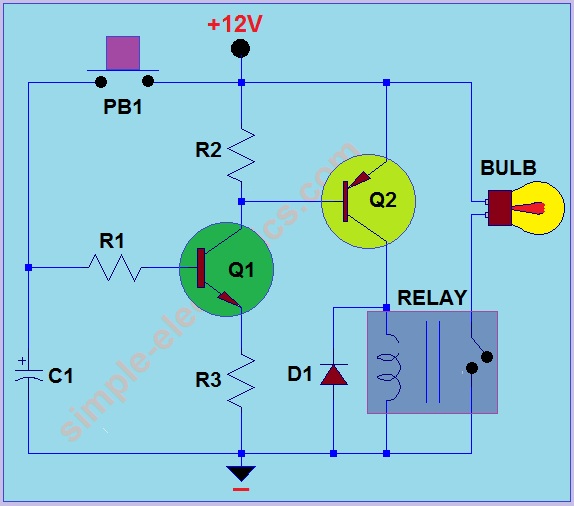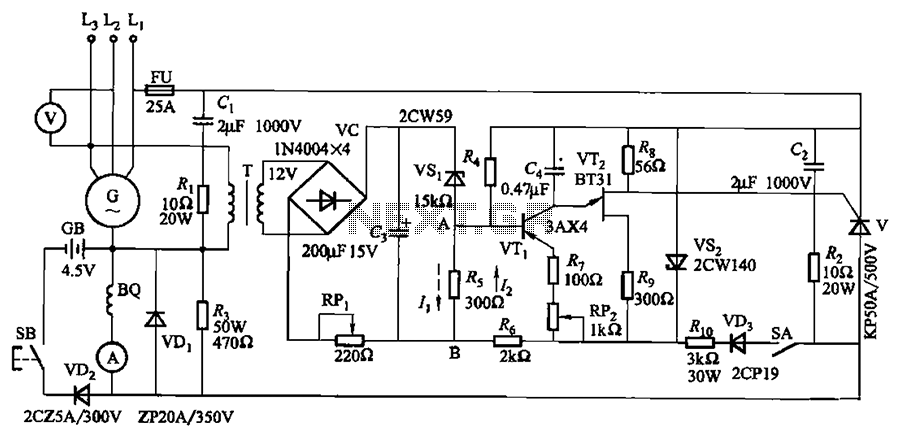
555 timer circuit temperature monitoring system
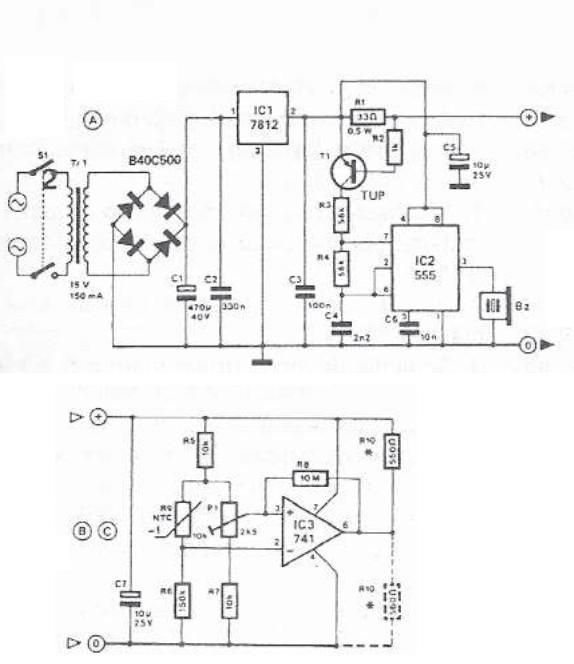
This 555 timer circuit temperature monitoring system project can monitor temperature at up to four points. The system allows for the selection of whether the alarm should be triggered when the temperature increases or decreases, depending on the resistance R10. If R10 is connected between the positive supply conductor and output 6 of IC2, the circuit will sound the alarm when the temperature rises above the reference temperature. The reference temperature is set by potentiometer P1. The measured temperature is monitored by the NTC resistor R9, whose value decreases as the temperature increases. Consequently, the voltage at the inverting input becomes greater than that at the non-inverting input, causing IC2's output to provide a low potential. The temperature relay then draws a current of approximately 20 mA. This current is sufficient for resistor R1 to develop a voltage of 0.65 V, which is adequate to turn transistor T1 into conduction mode and trigger the alarm sound. To configure the alarm for a lower temperature trigger, resistance R10 should be connected between output 6 (IC2) and ground. If the monitored temperature drops below the set reference value, the NTC resistor R9 increases in value, making the inverting input of IC2 more negative and increasing the positive potential of the output. The relay again draws a current of 20 mA, which triggers the alarm through T1. The 555 timer circuit is configured as an astable multivibrator, producing a frequency of approximately 4 kHz.
The 555 timer temperature monitoring system utilizes a combination of resistive temperature sensors, a potentiometer for reference setting, and a relay for alarm activation. The NTC thermistor (R9) serves as the primary temperature sensor, exhibiting a decrease in resistance as temperature rises. This behavior is critical for the functionality of the circuit, as it directly influences the voltage levels at the inputs of the operational amplifier (IC2).
The operational amplifier is configured to compare the voltage from the thermistor against a reference voltage set by the adjustable potentiometer (P1). The configuration of R10 determines the alarm triggering conditions. When R10 connects the positive supply to output 6 of IC2, the system is set to trigger the alarm on temperature increases. Conversely, connecting R10 to ground allows the system to trigger an alarm when the temperature decreases below the set reference value.
When the output of IC2 transitions due to the temperature changes, it controls the relay, which is rated to handle a load current of about 20 mA. This current is sufficient to activate the relay, allowing it to close the circuit and sound the alarm. The transistor (T1) acts as a switch, amplifying the control signal from the operational amplifier to drive the relay.
The astable multivibrator configuration of the 555 timer provides a continuous square wave output, which could potentially be used for periodic monitoring or as a sound signal for the alarm. The frequency of approximately 4 kHz ensures that the alarm sound is perceptible, alerting users effectively to temperature deviations.
Overall, this temperature monitoring system is versatile, allowing for configurations based on specific monitoring needs, whether for high or low-temperature alarms, making it suitable for various applications in environmental monitoring, HVAC systems, or any scenario requiring temperature oversight.This 555 timer circuit temperature monitoring system electronic project can be monitor temperature in up to four points. Using this 555 timer circuit temperature monitoring system electronic project can be choose if the alarm should be triggered when temperature is increased or decreased.
This depends on the resistance R10. If you connect R10 betw een positive supply conductor and output 6 of IC2 then circuit sound the alarm when the temperature rise over the reference temperature. The reference temperature is set by potentiometer P1. Measured temperature is monitored by NTC resistance R9. Its value decreases when temperature increases, as a result, the voltage at the inverting input is greater than the noninverting input, IC2`s output so provide a void potential.
Temperature relay now absorbs a current of about 20 mA. It is so great that the resistance R1 appear a voltage of 0. 65 V enough to pass transistor T1 in conduction state and trigger the alarm sound. If you want to lower temperature alarm trigger, then resistance R10 should be connected between the output 6 (IC2) and ground. If the monitored temperature falls below the adjusted to the reference value, then the NTC resistance R9 increases.
Inverting input of IC2 becomes more negative, so positive potential output increases. Now take the relay of the temperature again 20 mA current T1 alarm triggers. Timer circuit 555 is connected as astabil multivibrator which produces a frequency of about 4 kHz 🔗 External reference
The 555 timer temperature monitoring system utilizes a combination of resistive temperature sensors, a potentiometer for reference setting, and a relay for alarm activation. The NTC thermistor (R9) serves as the primary temperature sensor, exhibiting a decrease in resistance as temperature rises. This behavior is critical for the functionality of the circuit, as it directly influences the voltage levels at the inputs of the operational amplifier (IC2).
The operational amplifier is configured to compare the voltage from the thermistor against a reference voltage set by the adjustable potentiometer (P1). The configuration of R10 determines the alarm triggering conditions. When R10 connects the positive supply to output 6 of IC2, the system is set to trigger the alarm on temperature increases. Conversely, connecting R10 to ground allows the system to trigger an alarm when the temperature decreases below the set reference value.
When the output of IC2 transitions due to the temperature changes, it controls the relay, which is rated to handle a load current of about 20 mA. This current is sufficient to activate the relay, allowing it to close the circuit and sound the alarm. The transistor (T1) acts as a switch, amplifying the control signal from the operational amplifier to drive the relay.
The astable multivibrator configuration of the 555 timer provides a continuous square wave output, which could potentially be used for periodic monitoring or as a sound signal for the alarm. The frequency of approximately 4 kHz ensures that the alarm sound is perceptible, alerting users effectively to temperature deviations.
Overall, this temperature monitoring system is versatile, allowing for configurations based on specific monitoring needs, whether for high or low-temperature alarms, making it suitable for various applications in environmental monitoring, HVAC systems, or any scenario requiring temperature oversight.This 555 timer circuit temperature monitoring system electronic project can be monitor temperature in up to four points. Using this 555 timer circuit temperature monitoring system electronic project can be choose if the alarm should be triggered when temperature is increased or decreased.
This depends on the resistance R10. If you connect R10 betw een positive supply conductor and output 6 of IC2 then circuit sound the alarm when the temperature rise over the reference temperature. The reference temperature is set by potentiometer P1. Measured temperature is monitored by NTC resistance R9. Its value decreases when temperature increases, as a result, the voltage at the inverting input is greater than the noninverting input, IC2`s output so provide a void potential.
Temperature relay now absorbs a current of about 20 mA. It is so great that the resistance R1 appear a voltage of 0. 65 V enough to pass transistor T1 in conduction state and trigger the alarm sound. If you want to lower temperature alarm trigger, then resistance R10 should be connected between the output 6 (IC2) and ground. If the monitored temperature falls below the adjusted to the reference value, then the NTC resistance R9 increases.
Inverting input of IC2 becomes more negative, so positive potential output increases. Now take the relay of the temperature again 20 mA current T1 alarm triggers. Timer circuit 555 is connected as astabil multivibrator which produces a frequency of about 4 kHz 🔗 External reference
